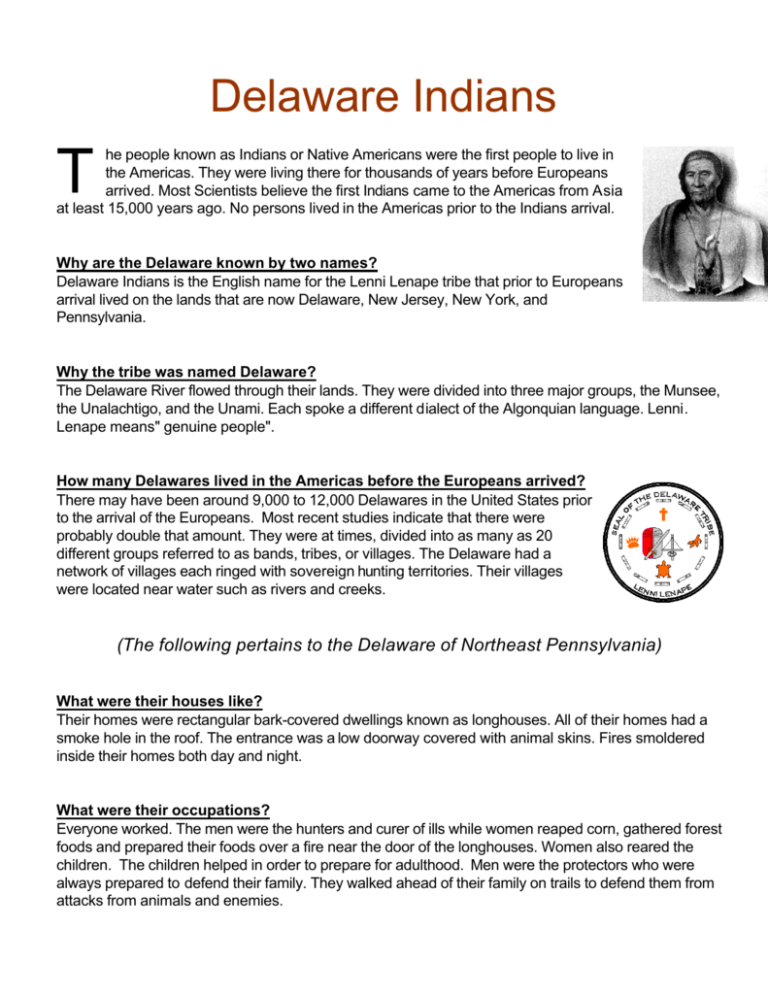Delaware Indians - Pencader Heritage Area Association
advertisement

Delaware Indians T he people known as Indians or Native Americans were the first people to live in the Americas. They were living there for thousands of years before Europeans arrived. Most Scientists believe the first Indians came to the Americas from Asia at least 15,000 years ago. No persons lived in the Americas prior to the Indians arrival. Why are the Delaware known by two names? Delaware Indians is the English name for the Lenni Lenape tribe that prior to Europeans arrival lived on the lands that are now Delaware, New Jersey, New York, and Pennsylvania. Why the tribe was named Delaware? The Delaware River flowed through their lands. They were divided into three major groups, the Munsee, the Unalachtigo, and the Unami. Each spoke a different dialect of the Algonquian language. Lenni. Lenape means" genuine people". How many Delawares lived in the Americas before the Europeans arrived? There may have been around 9,000 to 12,000 Delawares in the United States prior to the arrival of the Europeans. Most recent studies indicate that there were probably double that amount. They were at times, divided into as many as 20 different groups referred to as bands, tribes, or villages. The Delaware had a network of villages each ringed with sovereign hunting territories. Their villages were located near water such as rivers and creeks. (The following pertains to the Delaware of Northeast Pennsylvania) What were their houses like? Their homes were rectangular bark-covered dwellings known as longhouses. All of their homes had a smoke hole in the roof. The entrance was a low doorway covered with animal skins. Fires smoldered inside their homes both day and night. What were their occupations? Everyone worked. The men were the hunters and curer of ills while women reaped corn, gathered forest foods and prepared their foods over a fire near the door of the longhouses. Women also reared the children. The children helped in order to prepare for adulthood. Men were the protectors who were always prepared to defend their family. They walked ahead of their family on trails to defend them from attacks from animals and enemies. What did they wear? Delaware clothing was made from deerskins, and decorated with shell beads or porcupine quills, feathers, and other ornaments. The Lenape used a lot of copper which they obtained from traders from the Western Great Lakes. By 1750 the Lenape became stylish in their dress; clothing was decorated with bright cloth purchased from European traders. What crops did they grow? Where did they store their food? Corn, squash, beans, sweet potatoes, and tobacco were grown, and fields often covered more than 200 acres. Surplus food was stored in silos dug deep into the cool earth, then lined with marsh grass. A bark covering provided insulation. What were sweathouses? Indians built sweathouses beside creeks to purify themselves of ills, and evils. Sweathouses were constructed of stakes and mud, and were built low to the ground and windowless. Sweathouse doors were so low, even children had to crawl to enter. After steaming by pouring water on hot rocks, they cooled off in the river or creek, or rolled in the winter snow. Delawares cleaned and purified in steam baths once or twice a week. What was the religion of the Delaware? Religious ceremonies were centered around a dedicated "big house." Dreams were considered very significant, so Lenape priests were divided into two classes: those who interpreted dreams and divined the future; and those dedicated to healing. The Lenape believed in life after death and buried their dead in shallow graves. Did they get along with the Europeans when they arrived on their lands? When the Europeans arrived the Delawares taught them many new things, and the Delawares learned from the whites also. They both had different lifestyles. Some European's understood the Indians and treated them fairly; others cheated them and stole their land. Indians defended themselves at first with bows and arrows, but the Europeans had guns. Thousands of Indians were killed in battle. Many Europeans moved west and became a greater threat to the Indians way of life. What did they took like? Older men wore their hair long, but warriors usually had a scalp lock greased to stand erect called a "Mohawk," it was common to most of the eastern tribes. Women wore their hair long and often braided. Where did the term "Redskins" originate? Europeans called the Delaware Indians "Redskins" because of their reddish natural complexion, and the vermilion makeup they were fond of and decorated their bodies with. The paint consisted of fat mixed with berry juice and minerals. Their bodies were streaked with bright red ochre and bloodroot, and white and yellow clays. Delaware women applied decorative colors to their cheeks, eyelids, and ear rims. Who signed a treaty of friendship with the Delaware? In 1682 William Penn, an English colonial leader signed a treaty of friendship with the Delawares. According to legend, Penn and Tamenend, (or Tammany) a Delaware Indian Chief that the whites often spoke of as Saint Tammany, exchanged wampum belts under the now famous Shackamaxon elm near Philadelphia, Pa. Despite the treaty with Penn, Europeans took the Delawares’ land and gradually the tribes moved westward. During the 1760's a religious leader known as the Delaware prophet advised the Delawares to return to tribal ways to expel the Europeans and to abandon the use of firearms, steel, and other European inventions. The prophet influenced Pontiac, an Ottawa Native American leader to try and unite the Delawares and other Native Americans to attempt to drive out the intruders. Pontiac was defeated by the British in 1763. Prior to the Europeans arrival on Indian lands the Delaware were one of the two most powerful Indian groups in North America that lived in New York. The Delaware also lived in Newark, New Jersey before the Dutch set up a trading post there in 1666. Several tanners settled there in the late 1700's. Delawares lived in Trenton, New Jersey before the British occupied the area in the 1660's. The Delaware lived in the Wilmington, Delaware area prior to the Europeans arrival. In 1638, Swedish colonists arrived and planned to establish a fur-trading and shipping center along the river they called Christina. Delawares resided in the Jersey City, New Jersey area before the Dutch set up a trading post there in the 1600's. The post grew into a settlement called Paulus Hook. Two tribes of the Algonquian Indians lived in Delaware region when white explorers arrived. The Delaware tribe lived along the banks of the Delaware River. The Nanitoke lived along the Nanitoke River. By the mid 1700's white settlers forced most of the Native Americans out of the region. Did you know? In 1820 a small group of Delaware and the George Pogue and John McCormick families were the only people living in Indianapolis, Indiana when it was chosen to be a state capital. Where do they live now? In 1818 the Delaware surrendered their lands East of the Mississippi River to the government. Some moved to Indiana. The Muncie moved to Middletown. A majority of the Delaware moved to Missouri and then to Kansas. In the 1860's they moved to Oklahoma. Current population and Federally recognized Delaware There are around 16,000 Delaware today. Most residing in Oklahoma. Around 10,000 live in Eastern Oklahoma and were considered part of the Cherokee Nation until recently. They regained federal recognition as Delaware in Sept 1996 after a long struggle with the Bureau of Indian Affairs. Their tribal offices are in Bartlesville, Oklahoma. In Western Oklahoma, there is another federally recognized Delaware group. The groups 1,000 members are descendants of the Missouri-Texas Indians. Today many reside near tribal headquarters in Anadarko. Around 2,000 Munsee reside in Southern Ontario, Canada. There are 1,500 in Wisconsin and a tribe near Ottawa, Kansas. Oklahoma Delaware Tribes recognized The federally recognized Delaware tribes in Oklahoma recognize only two groups, the Sand Hill tribe of Lenape, and the Naticoke Lenape. They are uncertain about the New Jersey tribes. The Rampapough Mountain tribe in N.J. has almost 2,500 members. Northeast of Philadelphia is the Powhatan-Renape Nation consisting of Unami Delaware, Nanticoke, and Powhatan. Delaware groups without State or Federal recognition The Brotherton Indians in Wisconsin, and the Eastern Lenape nation in Pennsylvania. Did You Know? The late Carol Galantino, of Philadelphia, Pennsylvania, in her will gave her land back to the original owners of her land. The Delaware will receive 11½ acres of land. Yes, nearly 12 acres of land with a pond, wild rosebushes, grass, and other splendors of nature in a Philadelphia suburb. Carol passed away last year of leukemia. From the time she found arrowheads in a creek bed, she felt a connection to the Delaware and the land that was once their home. No decisions pertaining to the use of the land have been made. More info on Delaware Indians: www.delawareindians.com Feel free to use this information for research purposes. Copyright 2001 Linda Mouser




